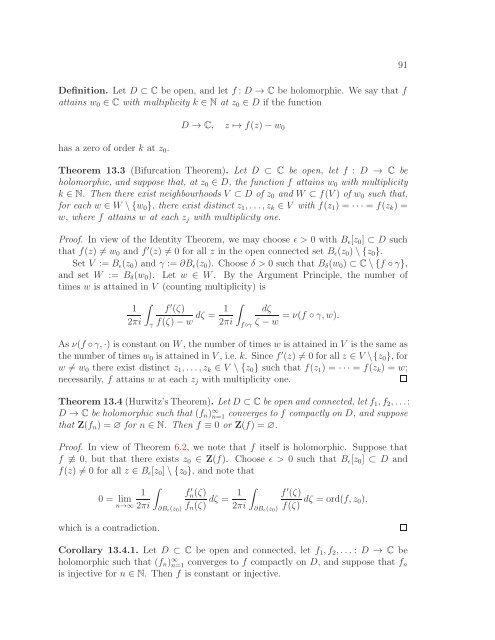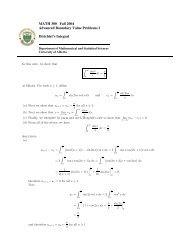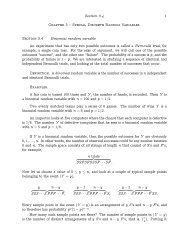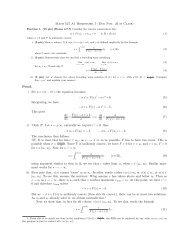Math 411: Honours Complex Variables - University of Alberta
Math 411: Honours Complex Variables - University of Alberta
Math 411: Honours Complex Variables - University of Alberta
You also want an ePaper? Increase the reach of your titles
YUMPU automatically turns print PDFs into web optimized ePapers that Google loves.
Definition. Let D ⊂ C be open, and let f: D → C be holomorphic. We say that f<br />
attains w0 ∈ C with multiplicity k ∈ N at z0 ∈ D if the function<br />
has a zero <strong>of</strong> order k at z0.<br />
D → C, z ↦→ f(z)−w0<br />
Theorem 13.3 (Bifurcation Theorem). Let D ⊂ C be open, let f : D → C be<br />
holomorphic, and suppose that, at z0 ∈ D, the function f attains w0 with multiplicity<br />
k ∈ N. Then there exist neighbourhoods V ⊂ D <strong>of</strong> z0 and W ⊂ f(V) <strong>of</strong> w0 such that,<br />
for each w ∈ W \{w0}, there exist distinct z1,...,zk ∈ V with f(z1) = ··· = f(zk) =<br />
w, where f attains w at each zj with multiplicity one.<br />
Pro<strong>of</strong>. In view <strong>of</strong> the Identity Theorem, we may choose ǫ > 0 with Bǫ[z0] ⊂ D such<br />
that f(z) �= w0 and f ′ (z) �= 0 for all z in the open connected set Bǫ(z0)\{z0}.<br />
Set V := Bǫ(z0) and γ := ∂Bǫ(z0). Choose δ > 0 such that Bδ(w0) ⊂ C\{f ◦γ},<br />
and set W := Bδ(w0). Let w ∈ W. By the Argument Principle, the number <strong>of</strong><br />
times w is attained in V (counting multiplicity) is<br />
�<br />
1<br />
2πi γ<br />
f ′ �<br />
(ζ) 1<br />
dζ =<br />
f(ζ)−w 2πi f◦γ<br />
dζ<br />
ζ −w<br />
= ν(f ◦γ,w).<br />
As ν(f ◦γ,·) is constant on W, the number <strong>of</strong> times w is attained in V is the same as<br />
the number <strong>of</strong> times w0 is attained in V, i.e. k. Since f ′ (z) �= 0 for all z ∈ V \{z0}, for<br />
w �= w0 there exist distinct z1,...,zk ∈ V \{z0} such that f(z1) = ··· = f(zk) = w;<br />
necessarily, f attains w at each zj with multiplicity one.<br />
Theorem 13.4 (Hurwitz’sTheorem). LetD ⊂ C be openandconnected, letf1,f2,...:<br />
D → C be holomorphic such that (fn) ∞ n=1 converges to f compactly on D, and suppose<br />
that Z(fn) = ∅ for n ∈ N. Then f ≡ 0 or Z(f) = ∅.<br />
Pro<strong>of</strong>. In view <strong>of</strong> Theorem 6.2, we note that f itself is holomorphic. Suppose that<br />
f �≡ 0, but that there exists z0 ∈ Z(f). Choose ǫ > 0 such that Bǫ[z0] ⊂ D and<br />
f(z) �= 0 for all z ∈ Bǫ[z0]\{z0}, and note that<br />
�<br />
1 f<br />
0 = lim<br />
n→∞ 2πi ∂Bǫ(z0)<br />
′ �<br />
n(ζ) 1 f<br />
dζ =<br />
fn(ζ) 2πi ∂Bǫ(z0)<br />
′ (ζ)<br />
dζ = ord(f,z0),<br />
f(ζ)<br />
which is a contradiction.<br />
Corollary 13.4.1. Let D ⊂ C be open and connected, let f1,f2,... : D → C be<br />
holomorphic such that (fn) ∞ n=1 converges to f compactly on D, and suppose that fn<br />
is injective for n ∈ N. Then f is constant or injective.<br />
91







